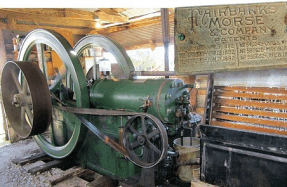ANOTHER BAD CONDENSER: Understanding The High-Tension Ignition System

Recently, a friend’s 1952 Clinton engine wouldn’t start. After some analysis, we narrowed the cause to spark. The component values may vary, but all high-tension ignitions are schematically identical. That made it easy to quickly determine that the condenser was bad. In his parts drawer, he had an old automotive condenser, likely for a 1949 Chevy. Could it be used to get the Clinton running again?
Before answering that question, it is very helpful, as well as necessary, to understand the high-tension ignition system and why the condenser exists. Figure 1 is the schematic for all hightension ignitions. In these systems, a changing magnetic field strength causes a current to flow in the primary coil through the closed points to ground. Changing is the key word in that sentence.
The amount of voltage that drives the current in the primary coil is directly related to the rate of magnetic field strength change that the coil experiences. A weak magnet will create a good spark if the system manages to change the field strength rapidly. On the other hand, a strong magnet will fail to deliver a good spark if the magnetic field strength changes slowly. It is easier to get a big change in the magnetic field strength quickly if you start with a strong magnetic field.
All high-tension ignitions use the same electrical schematic. The capacitor value may change and the number of turns in each coil may vary, but the base schematic never changes. Where they differ is the method used to create the changing magnetic field. Clinton and Maytag engines have a circular shaped magnet (or magnets) attached inside the flywheel, see Figure 2. As the flywheel turns, no magnetic field is generated. The N pole approaches and suddenly switches to the S pole, and then back to no field.
The popular Wico EK adds two large air gaps to the magnetic loop as it trips. Air is the worst possible medium for magnets; adding those air gaps causes the magnetic field strength to drop like a rock. The Wico Series A and many tractor magnetos, such as the Fairbanks Morse RV-2B, have a compact magnet that spins sitting adjacent to the primary coil.


Those are the three common methods of creating the changing magnetic field strength. Each creates a different looking and seemingly different behaving magneto, but from there on, all of them are identical. The Wico EK is rectangular and boxy in appearance, tractor magnetos are shaped like a loaf of bread, Maytags don’t appear to have a magneto, but underneath they all use the electrical schematic of Figure 1. It is a rather simple schematic, consisting of the condenser, a set of
You’re reading a preview, subscribe to read more.
Start your free 30 days





